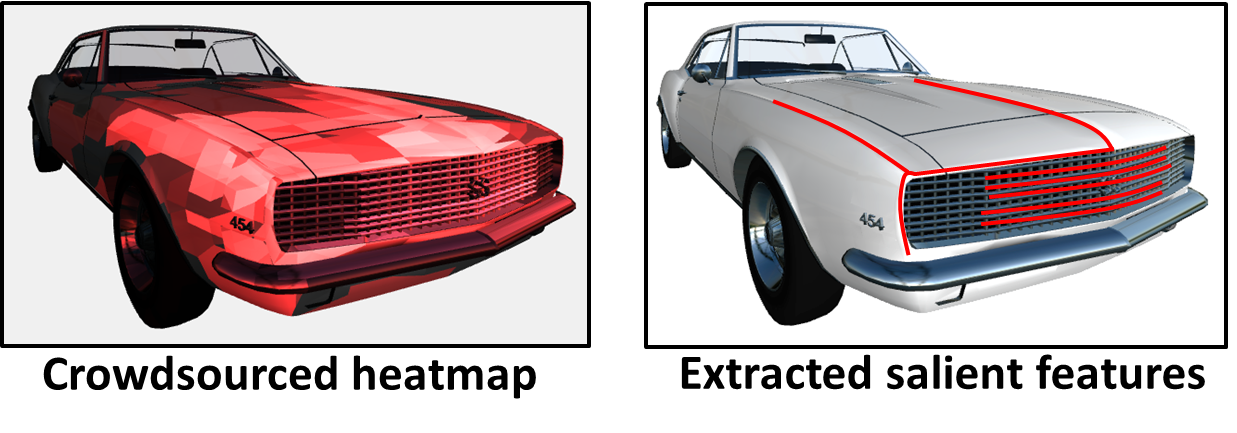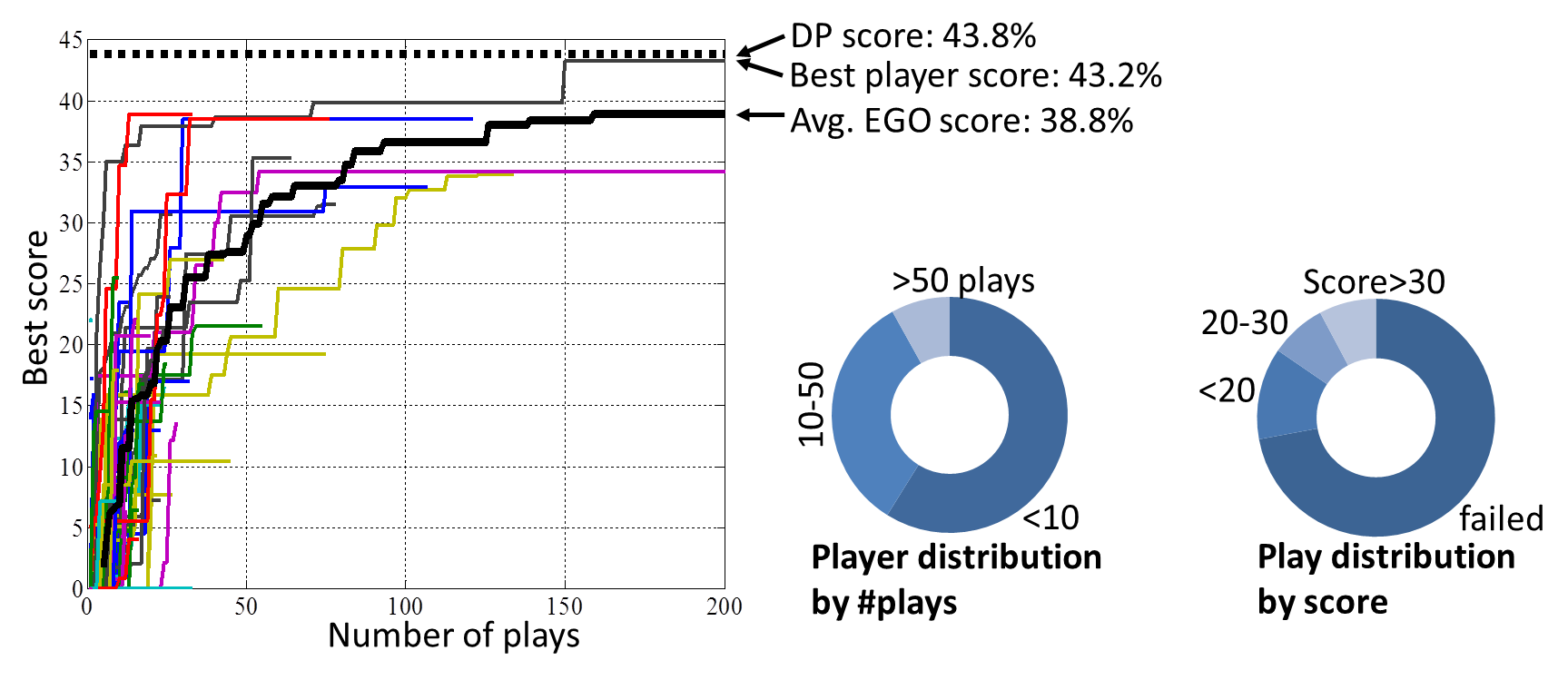Project Impressionist - we are looking for collaborators
with computer science background. Experience with Nodejs (or Django) is preferred. Impressionist
is a web game that helps to extract salient geometry features from 3D objects, aiming to enable context-aware feature suggestion and user-friendly editing of 3D printable objects.


Research Overview:
I am interested in developing human-computer interactions and computational tools to enhance the
experience of engineering and product design. My current work focuses on human computation, design crowdsourcing,
and adaptive preference modeling.
Projects on Human Computation
The complexity of engineering systems requires design solutions be searched from large sets of candidates, with expensive evaluations of each sampled design. Speeding up the search would enable more efficient material synthesis, vehicle energy management, and topology design, among many other design applications. Human computation - incorporating crowd intelligence in computation - has shown promise in solving optimization problems such as protein folding, RNA synthesis and gene segmentation, due to superior capability of human brain at spatial reasoning and pattern recognition. Our projects evaluate the utility of human computation in solving engineering design problems that are challenging for existing computation methods.
ecoRacer: Optimal Design and Control of Electric Vehicles Using Human Players
Collaborators: Ermah A. Bayrak and Panos Papalambros

The ecoRacer game translates the challenge of optimally designing and controling an electric vehicle into a racer game where players compete on energy consumption. Player strategies are then incorporated into a computer algorithm (EGO) to improve its efficiency.
Papers: coming soon
APPs: ecoRacer
The complexity of engineering systems requires design solutions be searched from large sets of candidates, with expensive evaluations of each sampled design. Speeding up the search would enable more efficient material synthesis, vehicle energy management, and topology design, among many other design applications. Human computation - incorporating crowd intelligence in computation - has shown promise in solving optimization problems such as protein folding, RNA synthesis and gene segmentation, due to superior capability of human brain at spatial reasoning and pattern recognition. Our projects evaluate the utility of human computation in solving engineering design problems that are challenging for existing computation methods.
ecoRacer: Optimal Design and Control of Electric Vehicles Using Human Players
Collaborators: Ermah A. Bayrak and Panos Papalambros

The ecoRacer game translates the challenge of optimally designing and controling an electric vehicle into a racer game where players compete on energy consumption. Player strategies are then incorporated into a computer algorithm (EGO) to improve its efficiency.
Papers: coming soon
APPs: ecoRacer
Projects on Design Crowdsourcing
Crowd evaluations when statistical models fail
Collaborators: Alex Burnap, Rich Gonzalez, Panos Papalambros)

While the challenge of aggregating crowd responses has long been studied, existing crowdsourcing tasks are often natural to human beings (e.g., image tagging), allowing statistical assumptions to be effective (e.g., responses are randomly distributed around the truth). The challenge with design evaluation tasks is that participants without proper knowledge can be biased towards the same wrong answer, leading to the failure of statistical models. This poses new challenges on design crowdsourcing: How should the human evaluation process be modeled? What crowd information shall we collect besides the evaluations?
Papers:
Burnap, A., Ren, Y., Papalambros, P. Y., Gonzalez, R. and Gerth, R., "When Crowdsourcing Fails: A Study of Expertise on Crowdsourced Design Evaluation", ASME Journal of Mechanical Design, 2014. (accepted)
APPs: Help Us Design
CrowdSAR: Crowdsourced search for disaster victims
Collaborators: Alex Burnap, Charles Barto, Rich Gonzalez and Panos Papalambros

Teams of unmanned aerial vehicles (UAV) have been suggested as sensor platforms for disaster victim search systems used shortly after natural disasters such as an earthquake or tsunami. Previous efforts have used UAVs equipped with video cameras for the disaster information gathering stage, with the information processing stage performed by either a single human operator or a victim detection computer vision algorithm. This project extends these efforts by investigating how a large and distributed "crowd" of search volunteers and professionals may augment the information processing stage by helping search video feeds for disaster victims.
Papers: coming soon
APPs: CrowdSAR
Crowd evaluations when statistical models fail
Collaborators: Alex Burnap, Rich Gonzalez, Panos Papalambros)

While the challenge of aggregating crowd responses has long been studied, existing crowdsourcing tasks are often natural to human beings (e.g., image tagging), allowing statistical assumptions to be effective (e.g., responses are randomly distributed around the truth). The challenge with design evaluation tasks is that participants without proper knowledge can be biased towards the same wrong answer, leading to the failure of statistical models. This poses new challenges on design crowdsourcing: How should the human evaluation process be modeled? What crowd information shall we collect besides the evaluations?
Papers:
Burnap, A., Ren, Y., Papalambros, P. Y., Gonzalez, R. and Gerth, R., "When Crowdsourcing Fails: A Study of Expertise on Crowdsourced Design Evaluation", ASME Journal of Mechanical Design, 2014. (accepted)
APPs: Help Us Design
CrowdSAR: Crowdsourced search for disaster victims
Collaborators: Alex Burnap, Charles Barto, Rich Gonzalez and Panos Papalambros

Teams of unmanned aerial vehicles (UAV) have been suggested as sensor platforms for disaster victim search systems used shortly after natural disasters such as an earthquake or tsunami. Previous efforts have used UAVs equipped with video cameras for the disaster information gathering stage, with the information processing stage performed by either a single human operator or a victim detection computer vision algorithm. This project extends these efforts by investigating how a large and distributed "crowd" of search volunteers and professionals may augment the information processing stage by helping search video feeds for disaster victims.
Papers: coming soon
APPs: CrowdSAR
Projects on Adaptive Preference Modeling
How much will you pay for styling?
Collaborators: Namwoo Kang, Fred Feinberg and Panos Papalambros

In this study we try to understand how much consumers would be willing to pay for changes in car styling. Quantifying consumer preferences with respect to product geometric representation allows us to choose design solutions that meet consumer preferences as well as engineering and manufacturing feasibility. Our project currently focuses on developing active learning techniques to efficiently learning from consumers through limited interactions.
Papers:
Ren, Y. and Papalambros, P. Y., "A Design Preference Elicitation Query as an Optimization Process", ASME Journal of Mechanical Design, Vol. 133, No. 11, 2011. (pdf)
Ren, Y., Burnap, A. and Papalambros, P. Y., "Quantification of Perceptual Design Attributes Using a Crowd", 19th International Conference on Engineering Design, Seoul, 2013. (pdf)
Ren, Y. and Papalambros, P. Y., "On Design Preference Elicitation with Crowd Implicit Feedback", ASME International Design Engineering Technical Conferences, Chicago, 2012. (pdf)
APPs: Complex Attribute Study
Adaptive Preference Modeling for Design Optimization
Collaborators: Fred Feinberg, Clayton Scott and Panos Papalambros

Finding the most profitable product configuration can be considered as a 20 Question Game where questions are asked smartly based on previous participants' responses, as well as engineering and cost models.
Papers:
Ren, Y. and Papalambros, P. Y., "Enhanced Adaptive Choice-Based Conjoint Analysis Incorporating Engineering Knowledge", Proceedings of the ASME 2014 International Design Engineering Technical Conferences, Buffalo, Aug 17-Aug 20, 2014. (pdf, presentation)
Ren, Y., Scott, C. and Papalambros, P. Y., "A Scalable Preference Elicitation Algorithm Using Group Generalized Binary Search", ASME International Design Engineering Technical Conferences, Portland, 2013. (pdf)
How much will you pay for styling?
Collaborators: Namwoo Kang, Fred Feinberg and Panos Papalambros

In this study we try to understand how much consumers would be willing to pay for changes in car styling. Quantifying consumer preferences with respect to product geometric representation allows us to choose design solutions that meet consumer preferences as well as engineering and manufacturing feasibility. Our project currently focuses on developing active learning techniques to efficiently learning from consumers through limited interactions.
Papers:
Ren, Y. and Papalambros, P. Y., "A Design Preference Elicitation Query as an Optimization Process", ASME Journal of Mechanical Design, Vol. 133, No. 11, 2011. (pdf)
Ren, Y., Burnap, A. and Papalambros, P. Y., "Quantification of Perceptual Design Attributes Using a Crowd", 19th International Conference on Engineering Design, Seoul, 2013. (pdf)
Ren, Y. and Papalambros, P. Y., "On Design Preference Elicitation with Crowd Implicit Feedback", ASME International Design Engineering Technical Conferences, Chicago, 2012. (pdf)
APPs: Complex Attribute Study
Adaptive Preference Modeling for Design Optimization
Collaborators: Fred Feinberg, Clayton Scott and Panos Papalambros

Finding the most profitable product configuration can be considered as a 20 Question Game where questions are asked smartly based on previous participants' responses, as well as engineering and cost models.
Papers:
Ren, Y. and Papalambros, P. Y., "Enhanced Adaptive Choice-Based Conjoint Analysis Incorporating Engineering Knowledge", Proceedings of the ASME 2014 International Design Engineering Technical Conferences, Buffalo, Aug 17-Aug 20, 2014. (pdf, presentation)
Ren, Y., Scott, C. and Papalambros, P. Y., "A Scalable Preference Elicitation Algorithm Using Group Generalized Binary Search", ASME International Design Engineering Technical Conferences, Portland, 2013. (pdf)
